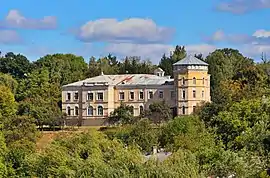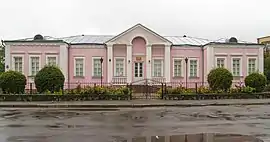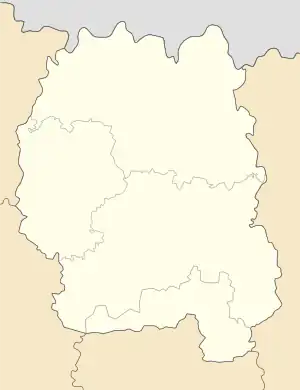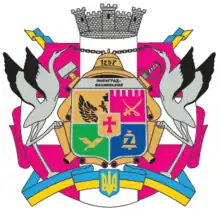Zviahel
Zviahel (Ukrainian: Звягель, IPA: [ˈzwjɑɦelʲ]; Yiddish: זוויל, romanized: Zvil) is a city in Zhytomyr Oblast, northern Ukraine. The city serves as the administrative center of Zviahel Raion (district). Population: 55,086 (2022 estimate).[1]
Zviahel
Звягель | |
|---|---|
    | |
 Flag  Coat of arms | |
 Zviahel Location of Zviahel  Zviahel Zviahel (Ukraine) | |
| Coordinates: 50°35′0″N 27°38′0″E | |
| Country | |
| Oblast | |
| Raion | |
| First mentioned | 1256 |
| City status | 1795 |
| Government | |
| • Mayor | Volodymyr Zahryvyi |
| Area | |
| • Total | 2,667 km2 (1,030 sq mi) |
| Elevation | 218 m (715 ft) |
| Population (2022) | |
| • Total | 55,086 |
| • Density | 21/km2 (53/sq mi) |
| Postal code | 11700—11709 |
| Area code | 1811000000 |
| Website | http://novograd.osp-ua.info/ |
Originally known as Zviahel, the city was renamed Novohrad-Volynskyi (Ukrainian: Новоград-Волинський) in 1795 after the region was annexed by Russia following the Third Partition of Poland and Zviahel becoming the center of the newly established Volhynian Governorate. On 16 June 2022, the city council restored the former name.[2] The decision on renaming the city was approved by the Ukrainian parliament on 16 November 2022.[3]
The city is located on the main route to Kyiv (![]() E40) near its crossing at the Sluch River. Located on Sluch, the city geographically is located on the eastern border of historical Volhynia (Volyn) or Volhynia Superior.
E40) near its crossing at the Sluch River. Located on Sluch, the city geographically is located on the eastern border of historical Volhynia (Volyn) or Volhynia Superior.
Name
The city has previously been known as: Возвягель Vozviahel, Звяголь Zviahol, Zviahel, Звягаль Zviahal, Dzwihel, Novohrad-Volynskyi.
Originally known as Zviahel, the city was renamed to Novohrad-Volynskyi in 1795 after annexation of territories of Polish–Lithuanian Commonwealth by the Russian Empire soon after the third Partition of Poland.[3]
Since the 1991 Act of Declaration of Independence of Ukraine there have been several attempts to rename the city.[2] Public discussions on renaming the city to Zviahel began in April 2022.[2] On 16 June 2022 the city council renamed the city again to Zviahel.[2] The decision was supported by 22 of the 30 deputies present, while four deputies opposed and abstained.[2] The name change was then to be approved by the deputies of the Zhytomyr Oblast Council[2] and the final decision on renaming the city had then to be made by the Ukrainian parliament,[2] which took place on 16 November 2022.[3]

On 31 March 2022 the city council had removed the letter Z (which was a reference to the name Zviahel and it was placed on the bell symbol) from its coats of arms.[4] This was done because letter Z was widely used by the invading Russian army during the 2022 Russian invasion of Ukraine and has become a propaganda tool in Russia.[4]
History
The city was mentioned in the Galician-Volhynian Chronicle under the year of 1256 as the town of Zviahel. The original settlement was an Old Ruthenian town of Bolokhiv Land located on the right bank of Sluch.[5] In 1257 it was razed by Daniel of Galicia.
The next mentioning of the settlement is found in 1432 as a rebuilt one on the left bank upstream from the original site.[5] Since 14th century it belonged to the Grand Duchy of Lithuania owned by Zwiahelski princely family.[5] In 1501 to 1554 the town belonged to Ostrogski princely family.[5] In 1507 Konstanty Ostrogski built here a castle.[5] After formation of Volhynian Voivodeship, it was located in Lutsk County. Following the 1569 Union of Lublin it was passed on to the Crown of Poland.[5]
During the Khmelnytsky Uprising, Cossacks destroyed portion of the city's fortification and burnt down the Catholic church (kosciol).[5] In September 1648 in the city was formed an insurgency group of local peasants led by Mykhalo Tysha.[5] In 1650s in Zwiahel existed Zwiahel Regiment.[5]
In 18th century the city belonged to Lubomirski princely family.[5]
The city had an important Jewish community. In the late 19th century it was home to 9,378 Jews, more than half the population of the town. Pogroms killed approximately 1,000 Jews in 1919.[6] After the Treaty of Riga, Novohrad-Volynskyi became part of the Ukrainian Soviet Socialist Republic of the Soviet Union. By the start of World War II only 6,840 Jews remained, (30% of the total population). Hundreds of Jews were murdered in mass executions perpetrated by an Einsatzgruppen in 1941. Many survivors were imprisoned in harsh conditions in a ghetto and murdered in November 1942,[7] and an important part of the town was destroyed during the war.
Geography
Climate
| Climate data for Novohrad-Volynskyi (1981–2010) | |||||||||||||
|---|---|---|---|---|---|---|---|---|---|---|---|---|---|
| Month | Jan | Feb | Mar | Apr | May | Jun | Jul | Aug | Sep | Oct | Nov | Dec | Year |
| Average high °C (°F) | −1.0 (30.2) |
0.3 (32.5) |
5.5 (41.9) |
14.0 (57.2) |
20.5 (68.9) |
23.0 (73.4) |
24.8 (76.6) |
24.3 (75.7) |
18.7 (65.7) |
12.5 (54.5) |
4.8 (40.6) |
0.1 (32.2) |
12.3 (54.1) |
| Daily mean °C (°F) | −3.3 (26.1) |
−2.8 (27.0) |
1.5 (34.7) |
8.6 (47.5) |
14.6 (58.3) |
17.3 (63.1) |
19.1 (66.4) |
18.2 (64.8) |
13.2 (55.8) |
7.8 (46.0) |
2.0 (35.6) |
−2.2 (28.0) |
7.8 (46.0) |
| Average low °C (°F) | −5.9 (21.4) |
−5.6 (21.9) |
−1.8 (28.8) |
4.0 (39.2) |
9.1 (48.4) |
12.2 (54.0) |
14.1 (57.4) |
13.1 (55.6) |
8.9 (48.0) |
4.2 (39.6) |
−0.3 (31.5) |
−4.4 (24.1) |
4.0 (39.2) |
| Average precipitation mm (inches) | 37.8 (1.49) |
37.1 (1.46) |
37.4 (1.47) |
41.9 (1.65) |
52.6 (2.07) |
86.9 (3.42) |
92.4 (3.64) |
63.5 (2.50) |
56.6 (2.23) |
40.8 (1.61) |
44.3 (1.74) |
43.3 (1.70) |
634.6 (24.98) |
| Average precipitation days (≥ 1.0 mm) | 9.2 | 9.4 | 9.1 | 8.2 | 8.5 | 10.6 | 10.4 | 8.2 | 8.8 | 7.7 | 8.6 | 10.0 | 108.7 |
| Average relative humidity (%) | 83.6 | 81.7 | 77.2 | 68.3 | 67.9 | 72.8 | 74.1 | 74.1 | 78.4 | 79.9 | 84.4 | 85.4 | 77.3 |
| Source: World Meteorological Organization[8] | |||||||||||||
Notable people
- Lesya Ukrainka (1871–1913), poet and writer
- Valerii Zaluzhnyi (1973), general and Commander-in-Chief of the Armed Forces of Ukraine
- Oleh Hychko (1996–2022), soldier
- Peter Krasnow (1886–1979), artist
- Elena Yakovleva (born 1961), actress
- Baruch Korff (1914-1995), Jewish activist known as "Nixon's rabbi"
- Oleksandr Kovalchuk (1974), politician
- Sam Muchnick (1905-1998), professional wrestling promoter (National Wrestling Alliance)
Twin towns – sister cities
 Bełchatów, Poland
Bełchatów, Poland Dolyna, Ukraine
Dolyna, Ukraine Halych, Ukraine
Halych, Ukraine Khashuri, Georgia
Khashuri, Georgia Łomża, Poland
Łomża, Poland Ludwigshafen, Germany
Ludwigshafen, Germany Myrhorod, Ukraine
Myrhorod, Ukraine Rahachow, Belarus
Rahachow, Belarus Suomussalmi, Finland
Suomussalmi, Finland
Gallery
 Mezentsev Palace
Mezentsev Palace Railway station
Railway station Lesya Ukrainka's house
Lesya Ukrainka's house Holocaust monument
Holocaust monument_102.jpg.webp) Dzwihel is between Teteriv and Sluch
Dzwihel is between Teteriv and Sluch Zviahel Fortress (reconstruction)
Zviahel Fortress (reconstruction) Zviahel Fortress over Sluch River
Zviahel Fortress over Sluch River Lesya Ukrainka Square
Lesya Ukrainka Square
References
- Чисельність наявного населення України на 1 січня 2022 [Number of Present Population of Ukraine, as of January 1, 2022] (PDF) (in Ukrainian and English). Kyiv: State Statistics Service of Ukraine. Archived (PDF) from the original on 4 July 2022.
- (in Ukrainian) Novohrad-Volynskyi was renamed Zviahel - deputies returned the historical name of the city, Suspilne Movlennia (16 June 2022)
- (in Ukrainian) In Ukraine, the city of Novohrad-Volynskyi was renamed, Ukrainska Pravda (16 November 2022)
- (in Ukrainian) Change of symbols: in Zhytomyr region the letter "Z" was removed from the coats of arms of one of the communities, Suspilne Movlennia (31 March 2022)
- Zvizdetskyi, B. Vozvyahl (ВОЗВЯГЛЬ). Encyclopedia of History of Ukraine. 2003
- Ron Doctor (2018-09-30). "Zhvil, Novohrad-Volins'kyy, ShtetLinks - JewishGen.org". Kehilalinks.jewishgen.org. Retrieved 2022-03-16.
- המכון הבין-לאומי לחקר השואה - יד ושם. Yad Vashem (in Hebrew).
- "World Meteorological Organization Climate Normals for 1981–2010". World Meteorological Organization. Archived from the original on 17 July 2021. Retrieved 17 July 2021.
- "Міста-партнери Звягелю". novograd.osp-ua.info (in Ukrainian). Novohrad-Volynskyi. Archived from the original on 2021-11-28. Retrieved 2020-04-02.
External links
- Official Web Site Archived 2020-12-05 at the Wayback Machine (expired)
- Novohrad-Volynskyi. Encyclopedia of Ukraine
- (in English) Find out Novograd-Volynskyi @ Ukrainian.Travel